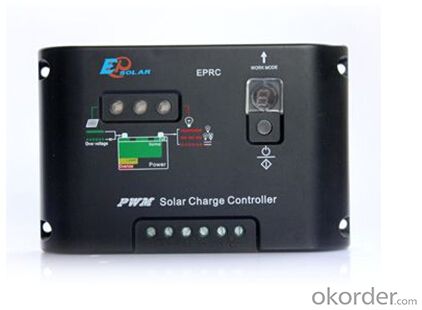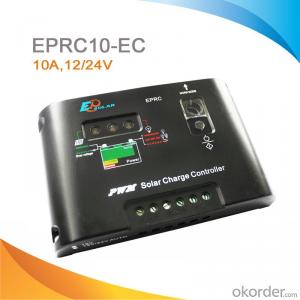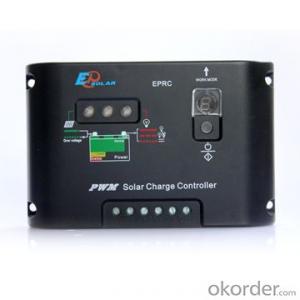Solar Street Light Controller,10A,12/24V,EPRC10-EC
- Loading Port:
- Tianjin
- Payment Terms:
- TT or LC
- Min Order Qty:
- -
- Supply Capability:
- 10000 pc/month
OKorder Service Pledge
OKorder Financial Service
You Might Also Like
EPRC10-EC series solar controller is a reliable and economical solar controller.
Dusk to Dawn, Light ON+ timer, TEST, ON/OFF
Features:
·Intelligent System Optimum Control
·12/24V auto work
·High efficient Series PWM charging with temperature compensation
·Use MOSFET as electronic switch, without any mechanical switch
·Load and battery status indicators
·Electronic protection: over charging, over discharging, overload, and short circuit
·Diversified load control modes : Manual, Light ON/OFF, Light ON+ Timer, Time Control
·Battery type selection: Gel, sealed, flooded and User type
·Real-time monitor
·Programmable parameters
·LVD or SOC load disconnect function
·Energy statistics function
Electronic Protections:
·PV short circuit
·PV reverse polarity
·Battery overcharge
·Battery over discharge
·Battery reverse polarity
·Load short circuit
·Load overload
·Overheating
Specification:
Electrical parameters | |
System voltage | 12 / 24VDC Auto work |
Nominal battery current | 10A |
Charge circuit voltage drop | ≤0.26V |
Discharge circuit voltage drop | ≤0.15V |
Self consumption | ≤6mA |
Equalize charging voltage | 14.6V;x2/24V |
Boost charging voltage | 14.4V;x2/24V |
Float charging voltage | 13.6V;x2/24V |
Low voltage reconnect charging voltage | 12.6V;x2/24V |
Under voltage warning voltage | 12V; x2/24V |
Low voltage disconnect voltage | 11.1V;x2/24V |
Equalize duration | 60 MINS |
Boost duration | 60 MINS |
Working temperature | -35℃ to +55℃ |
Humidity | 10%-90% NC |
Enclosure | IP30 |
Terminal | 2.5mm2 |
Net weight | 0.23kg |

FAQ:
Q1. What is the voltage?
A1. Our 45/60A solar charge controller is 12/24/36/48V auto work.
Q2. What is the difference between MPPT&PWM?
A2. MPPT has higher efficiency, it can track the max power point and won't waste energy.
Q3. What is the efficiency of the MPPT controller?
A3. MPPT>99%, peak conversion efficiency>98%.
Q4. What is the waranty of product?
A4. 12 months.
Q5. What protection does your MPPT controller have?
A5. PV array short circuit, PV reverse polarity, Battery reverse polarity, Over charging, Output short circuit.
- Q:Can a solar controller handle low light conditions?
- Yes, a solar controller can handle low light conditions. Solar controllers are designed to regulate the flow of electricity from solar panels to batteries, and they have the ability to adapt to varying light conditions. They can adjust the charging parameters to optimize the energy conversion even in low light situations, ensuring efficient power generation and storage.
- Q:What are the different types of solar controllers?
- The different types of solar controllers include PWM (Pulse Width Modulation) controllers and MPPT (Maximum Power Point Tracking) controllers.
- Q:Can a solar controller be used with solar panel snow melting systems?
- Yes, a solar controller can be used with solar panel snow melting systems. A solar controller is an essential component for any solar system, including snow melting systems. It helps regulate and optimize the power output of the solar panels to ensure efficient and safe operation. In the case of a snow melting system, the solar controller plays a crucial role in managing the power supply to the heating elements that melt the snow. It monitors the energy generated by the solar panels and controls the flow of electricity to the heating elements, based on the ambient temperature and the presence of snow or ice. The solar controller also helps prevent overheating of the heating elements by adjusting the power supply as needed. It can also provide data and diagnostics to monitor the performance of the system and troubleshoot any issues. In summary, a solar controller is an essential component for a solar panel snow melting system, as it helps regulate and optimize the power supply to the heating elements, ensuring efficient and safe operation.
- Q:What is the maximum load power a solar controller can handle?
- The maximum load power that a solar controller can handle depends on the specific model and specifications of the controller. It can range from a few hundred watts to several kilowatts, depending on the controller's design and capabilities.
- Q:How does a solar controller handle battery low voltage protection?
- A solar controller handles battery low voltage protection by monitoring the voltage level of the battery. When the voltage drops below a certain threshold, the controller automatically disconnects the load from the battery to prevent over-discharging, which can damage the battery. This helps to prolong the lifespan of the battery and ensures its optimal performance.
- Q:Can a solar controller be used for off-grid cabins or RVs?
- Yes, a solar controller can be used for off-grid cabins or RVs. A solar controller is an essential component of a solar power system, regulating the flow of electricity from the solar panels to the battery bank. It ensures that the batteries are charged efficiently and protects them from overcharging or damage. Whether it's an off-grid cabin or an RV, a solar controller helps optimize the use of solar energy and ensures a reliable and sustainable power supply.
- Q:Can a solar controller be used with solar-powered security cameras?
- Yes, a solar controller can be used with solar-powered security cameras. A solar controller helps regulate the power generated by the solar panels and ensures that the cameras receive a consistent power supply. This is crucial for the proper functioning of the security cameras and ensures uninterrupted surveillance.
- Q:Can a solar controller be used with solar panels that are connected to a load directly?
- Solar panels that are connected directly to a load cannot be used with a solar controller. The purpose of a solar controller, also known as a charge controller, is to regulate the charging of batteries in a solar power system. Its main function is to prevent overcharging of the batteries and ensure efficient charging. Without a charge controller, when solar panels are connected directly to a load, there is no control over the voltage and current output from the panels. This can result in either overcharging or undercharging of the batteries, depending on the sunlight conditions and load requirements. Overcharging can cause damage to the batteries, while undercharging can restrict the power supply to the load. Therefore, it is crucial to incorporate a solar controller into a solar power system to oversee the charging process and maintain the batteries properly.
- Q:Can a solar controller handle power fluctuations from the charge controller?
- Yes, a solar controller is designed to handle power fluctuations from the charge controller. It regulates and stabilizes the incoming power from the charge controller, ensuring a steady flow of power to the connected devices or battery bank.
- Q:What is the maximum number of solar panels that a solar controller can handle?
- The maximum number of solar panels that a solar controller can handle depends on the specifications and capabilities of the controller itself. The capacity of a solar controller is typically defined by its maximum input voltage and current rating. Solar panels generate electricity in the form of direct current (DC), and a solar controller is responsible for regulating and optimizing the flow of this DC power to charge a battery bank or supply an electrical load. The controller must be able to handle the voltage and current produced by the connected solar panels without exceeding its own limits. Therefore, to determine the maximum number of solar panels a controller can handle, one needs to consider the voltage and current ratings of the solar panels and compare them to the controller's specifications. By dividing the maximum input voltage and current rating of the controller by the corresponding values of the solar panels, one can estimate the maximum number of panels that can be safely connected. It is important to note that exceeding the maximum capacity of a solar controller can lead to performance issues, such as reduced efficiency, overheating, or even damage to the controller. Therefore, it is crucial to carefully check the controller's specifications and ensure that the total voltage and current of the connected solar panels do not exceed its limits for reliable and safe operation.
1. Manufacturer Overview |
|
|---|---|
| Location | |
| Year Established | |
| Annual Output Value | |
| Main Markets | |
| Company Certifications | |
2. Manufacturer Certificates |
|
|---|---|
| a) Certification Name | |
| Range | |
| Reference | |
| Validity Period | |
3. Manufacturer Capability |
|
|---|---|
| a)Trade Capacity | |
| Nearest Port | |
| Export Percentage | |
| No.of Employees in Trade Department | |
| Language Spoken: | |
| b)Factory Information | |
| Factory Size: | |
| No. of Production Lines | |
| Contract Manufacturing | |
| Product Price Range | |
Send your message to us
Solar Street Light Controller,10A,12/24V,EPRC10-EC
- Loading Port:
- Tianjin
- Payment Terms:
- TT or LC
- Min Order Qty:
- -
- Supply Capability:
- 10000 pc/month
OKorder Service Pledge
OKorder Financial Service
Similar products
New products
Hot products
Related keywords





























